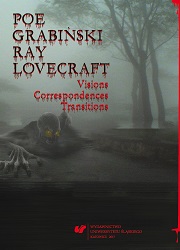The Madwoman by the Fireplace: A Comparative Survey of Gothic Horror by Edgar Allan Poe and Harriet Prescott Spofford
The Madwoman by the Fireplace: A Comparative Survey of Gothic Horror by Edgar Allan Poe and Harriet Prescott Spofford
Author(s): Gianna Carroni
Subject(s): Literary Texts, Studies of Literature, Philology, Theory of Literature
Published by: Wydawnictwo Uniwersytetu Śląskiego
Keywords: Edgar Allan Poe; Harriet Prescott Spofford; comparative literature; short story; ghost story; madness
Summary/Abstract: The purpose of this study is to identify and highlight parallelisms between short stories by Edgar Allan Poe (1809–1849) and Harriet Prescott Spofford (1835–1921). An extraordinary prolific author, praised by Emily Dickinson, Rose Terry Cooke, and Henry James, Spofford can be seen as one of the “mothers” of American detective fiction (“In a Cellar,” “Mr. Furbush,” “In the Maguerriwock” recall Poe’s tales of ratiocination), and a skilled writer of both adventure and gothic stories. A long life, a successful career, and a happy marriage make Spofford’s personal history radically different from Poe’s tormented existence, undermined by alcohol abuse, loneliness, and poverty. Nevertheless, it is not unusual to find in Spofford’s works several themes that are recurrent in Poe’s literary world: madness, demonic women, characters with a morbid sensitivity, and an egocentric and amoral personality. Both authors challenged the conventional genres of their time and anticipatedthe Freudian unravelling of deranged psyche. Yone, the protagonist of “The Amber Gods,” is a disturbing narrating voice emerging from the grave (echoing Poe’s theme of premature burial). From her room in a psychiatric asylum, the protagonist of “Her Story” tells of the vampire‑like woman that took away her husband’s love and led her to madness, the narratorthus providing the terribly rational description of a neurotic mind. In “In the Maguerriwock,” a female figure sits by the fireplace, maddened with her husband’s abuses and the horror of the dreadful awareness that “three men went down cellar, and only two came up”; the corpse of a peddler lies under the pavement of the cider‑cellar, recalling “The Tell‑Tale Heart” and“The Black Cat.” Whereas Poe dealt with madness in male characters, ascribing it to perverseness, “one of the indivisible primary faculties or sentiments which give direction to the character of Man” (1899: 170), Spofford explores what could be defined as “domestic madness.” The fireplace is the symbol of domestic peace and family happiness, traditionally linked with a female figure; however, Spofford’s heroines are “madwomen” in the eyes of society, breaking the boundaries of “normality” and “morality,” breaking the “angel of thehearth” imagery to get what they yearn for (love, power, independence). Some of them are “mad” because they are “different,” or they have been driven to madness by horror and grief. In a repressive and violent society, madness represents the woman’s reaction.
Book: Poe, Grabiński, Ray, Lovecraft. Visions, Correspondences, Transitions
- Page Range: 77-90
- Page Count: 14
- Publication Year: 2017
- Language: English
- Content File-PDF

